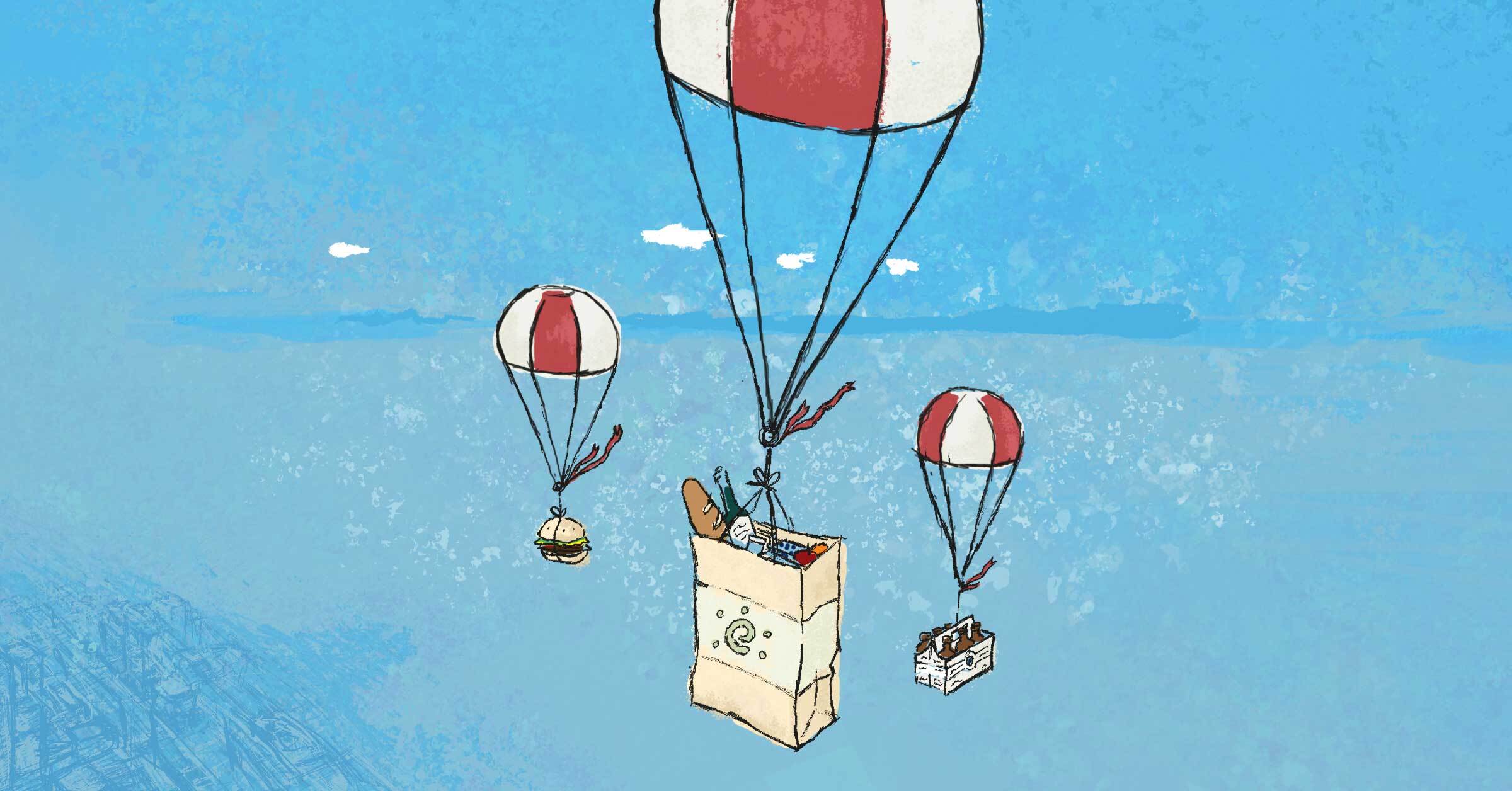
How Food & Beverage Brands Are Adapting Post COVID-19
Wednesday April 22nd, 2020The Brolik team digs into some creative ideas and strategies that Philly-area food and beverage companies are implementing to reach customers at home, grow their audience, and make it through the crisis.
This article is the second in our “New Normal” series, where we take a deep dive into the ways that businesses are creatively responding to the unique challenges COVID-19 is imposing on them. Click here to read our first article on identifying opportunities during a crisis.
Estimated reading time: 20 min
This article includes:
- Changes and new trends in consumer behavior and shopping behavior
- Analyzing the difference between essential and non-essential food and beverage consumption
- Examples of regional food & beverage brands investing in online + off-premise sales
- Opportunities for food & beverage brands to take advantage of lower costs or better performing channels
- Examples of food and beverage brands shifting strategy to reach their customers in new ways
One month after Pennsylvania’s order to close down bars, taprooms, and restaurant dining rooms, one thing is certain: no one was prepared for this. Everyone has been impacted, from mom-and-pop operations to large corporations. So how have they been coping?
Out of sheer strength of will to survive, we’ve seen some really creative solutions from many companies to get through this crisis and still have an operating business on the other side. Across the board, restaurants, bars, manufacturers, and distributors are pivoting, making nimble moves and quick decisions to replace some of the revenue that’s been lost — and to help out their community.
While no one is having the time of their lives right now, these creative tactics are encouraging for everyone. It shows other companies that there is a way through this crisis, even if it means changing everything. Because even though we’re all staying home, we still need to eat.
“Good food and drink is one of the few joys we have right now, and food and beverage brands can be a bright spot during a difficult time, if they can seize the opportunity.”
While many brands are just trying to survive, a lot of them are also thinking about the future of the industry and what that looks like in a post-shutdown world, where social distancing is the norm and people are reluctant to venture into crowded spaces.
- What will restaurants look like six months or a year from now?
- How will this change the industry that has barely changed in the past fifty years?
- How can food and beverage businesses start to adapt to make sure that they not only survive the shutdown, but can keep up with long-term effects on the industry?
- Can Wine & Spirits get their act together? (Just kidding, this won’t happen)
We’ve spent the last few weeks reaching out to food and beverage companies in the Philadelphia area, looking to understand what they’re going through and how they are pivoting to take advantage of opportunities — and survive. We’ve spoken to companies with a variety of business models, all of whom have had to adapt in some way. Hopefully this article will provide some insight and spark some ideas about what your company can do to make it through the crisis, too.
This is a long read, so if you’d like, you can use the links below to jump ahead to a specific section:
Navigating the Economics of Delivery and Pickup
Adapting to the Future of the Food Industry
Now is the Time to Launch and Expand Your E-commerce Push
New Offerings Designed for Strange Times
Go Where the Conversation is Happening
Support Your Community and They Will Support You Back
Navigating the Economics of Delivery and Pickup
The most obvious transition that brands are making is shifting to a delivery and pickup only model. For some companies it’s an easier transition than others. Restaurants tend to have a leg up here, because many of them were already offering delivery, whether in-house or through a third party. For restaurants that weren’t already delivering, and for breweries and distilleries, it’s been a big change as they scramble to set up delivery and no-contact pickup infrastructure for the first time.
Love City Brewing is one of those breweries. Their revenue came entirely from their taproom and from selling to restaurants and bars, so they’ve had to completely change their business model in the past few weeks in order to survive. Luckily, under their liquor license, they are allowed to deliver directly to consumers in their homes.
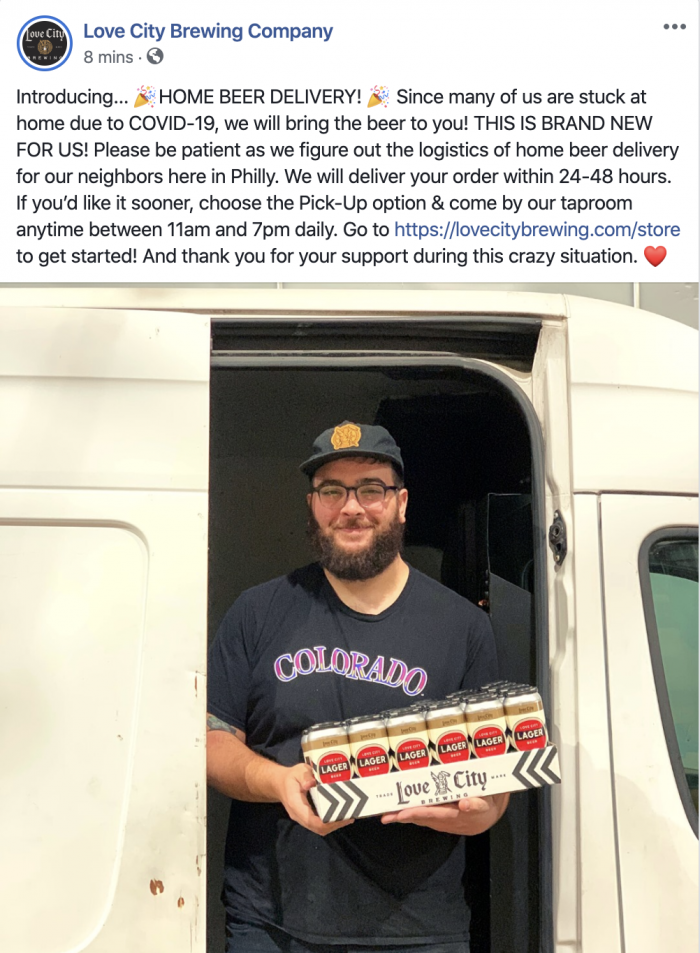
“Home beer delivery is the only thing keeping us afloat right now,” says owner Melissa Walter.
They managed to get the delivery service up and running within 24 hours of their taproom being forced to close. “Home beer delivery is the only thing keeping us afloat right now,” says owner Melissa Walter. “It’s something we didn’t think we’d ever do, because we have the taproom. But now, we’re considering what it would look like to keep this as a part of our business going forward.”
Similarly, when Boardroom Spirits had to close their tasting rooms and their restaurant orders dropped off, they started offering drive-through pickup of pre-batched cocktails and bottles of liquor. They quickly spun up a Squarespace website for placing orders. “It has helped us provide a viable business model that reaches people who normally might not have the chance to visit our tasting rooms,” says co-owner Zsuzsa Palotas. “We are selling out of product listed on the site daily and continue to update it with new items as they are ready for the public.”
For brands like Boardroom Spirits, keeping up with new online demand and servicing customers off-premise is a big change that takes some getting used to. With the PA Liquor Control Board scrambling to serve the needs of online customers, distilleries are forced to be their own distributors.

Takeaway: Offering delivery can expand your audience reach, allowing people to test something from a local brewery or distillery that they may never have ventured into.
So We All Just Become Delivery and Logistics Companies? Not So Fast
One trend we’ve noticed is that almost every company we’ve talked to is struggling with the finances and logistics of delivery. One business owner we talked to said, “The economics of home delivery are really bad. It’s keeping cash flowing, but it’s tough.” Margins are already slim in the food and beverage industry, and even more so now, so it’s a challenge to figure out the logistics of delivering at scale without sacrificing profits.
Many companies have taken to third-party delivery services like GrubHub and Caviar to fill that gap, but that comes with its own set of problems and for many businesses it’s not a sustainable practice. Typically the third-party services charge high fees, further slimming down margins, and overall cause a lot of headaches for restaurants. It’s not a partnership; the third-parties hold all the power in the relationship, and as a result they feel free to throw their weight around and disregard the best interests of the restaurants they work with.
This is why some companies have decided to set up in-house delivery, but it’s much harder than it may initially seem. Many business owners we talked to were trying to figure out how to deliver efficiently in order to waste as little money and time as possible, while still showing the customer savings — offering free delivery, for example.
Workhorse Brewing, another local brewery forced to change their business model overnight, has identified one major trend that serves as a clue for how to solve this business problem: an increase in average order size per customer. “The average sale per customer is nearly 2.5x (~$20 before, $45-$50 now) since we shifted to the new model. Seems like people want to limit their transactions and instead stock up,” notes owner Dan Hershberg.

Taking advantage of this trend from a business perspective means structuring deliveries so that they are concentrated around a reasonably-sized location, instead of backtracking all around the city. But that assumes you are driving sales of your product in a very controlled way, both in terms of scheduling and geographic targeting of promotions.
The team at Brolik has been supporting some of these brands with ideas for their paid advertising strategies, to help generate awareness and drive profitable conversions. One strategy that can help with batching sales & deliveries is using geo-targeted advertising. Digital ad platforms allow you to advertise only within certain zip codes or target a radius around a specific address. If you build out a highly-targeted ad campaign, you can reach only the people in the locations where it’s easiest for you to deliver.
Structuring delivery windows to allow for batching is also helpful here, at least if your product is conducive to non-instant delivery. Set a high enough goal for sales and meet a threshold of deliveries that is going to be profitable in one area of the city, and then deliver them all in the same efficient route.
Takeaway: Geo-targeted, goal-oriented marketing can improve the profitability of delivery.
One benefit of this shift to deliver-your-own (outside of not having to deal with third-party problems) is the ability to completely own the relationship with your customers, from end-to-end, just like you would if they were going to your business in person. Owning the marketing relationship is important because it gives you the control over how your business is presented to customers, the entire customer experience, and you collect crucial information about your customers that you can use for all future marketing efforts. This is something that simply can’t be done when using third-party ordering and delivery platforms.
For example: if customers are ordering directly from you, you’ll naturally collect their contact information and their unique preferences around your products. You can use this information to build out email marketing lists and run future campaigns, re-engaging these same customers for life. You can also use this information to build out lookalike audiences for your digital ad campaigns to find similar people who you can then target and nurture into customers.
Key Learnings
Unsurprisingly for Philly, we’ve seen a lot of scrappiness in the way brands are adjusting to the crisis, setting up ad-hoc delivery services and throwing up simple websites in the blink of an eye. Remember, everyone is living on the edge right now, and no one expects perfection.
Your strategy doesn’t have to be complicated or over-engineered, and experimenting with new tactics is better than waiting for things to go back to normal. Batching deliveries, using geo-targeted advertising, and doing the math on third-party service fees versus in-house delivery or courier services, can all help to keep your margins intact. While we’re all thinking about the short term, there is long term value of investing in your own capabilities and benefitting from the learnings that come from it.
Adapting to the Future of the Food Industry
With so many restaurants losing their dine-in revenue almost overnight, it has become a struggle for survival. Let’s talk about the potentially scary future for restaurants. If the dine-in traffic never quite returns to normal, then what? For now, they’re trying just about anything to bring in revenue from their local customers, like becoming grocery stores to meet a need. But many companies are starting to think about the long-term effects on the industry, and how they will need to adapt for the future.
There is one business model that may be a sign of the future to come: ghost kitchens. Ghost kitchens are believed by some to be the future of restaurants. A ghost kitchen is essentially a restaurant without a public location — it operates solely through delivery, cooking in a rented kitchen space and using in-house or third-party delivery services to reach their customers. With lower overhead costs due to no prime-location rent or wait staff, it’s a more economical alternative to a traditional brick and mortar restaurant. And in the age of coronavirus, these features set ghost kitchens up for success.
We talked with Tyler Wiest from Zuul Kitchens (which recently acquired Philly startup Ontray), who sees the current situation as possibly jumpstarting the growth of ghost kitchens and virtual restaurants, pushing companies away from expensive locations and towards delivery-based business models. Tyler says, “Ghost kitchens will become a bigger piece of this. You limit overhead and dine-in space, combine space with other brands and offer pre-packaged foods for delivery and pick up only.”
Another company that was perhaps in a better position to quickly adjust is Simply Good Jars. The company provides pre-made meals and salads in jars, typically to offices. So while they didn’t have any public-facing locations to shutter, they too have had to make an adjustment in their business model. They quickly moved to offer residential deliveries of 5 or 8 packs of jars. They’re relying on organic social media and email marketing to promote their new offering, with no paid campaigns yet, resulting in around $6,000 worth of orders each week.
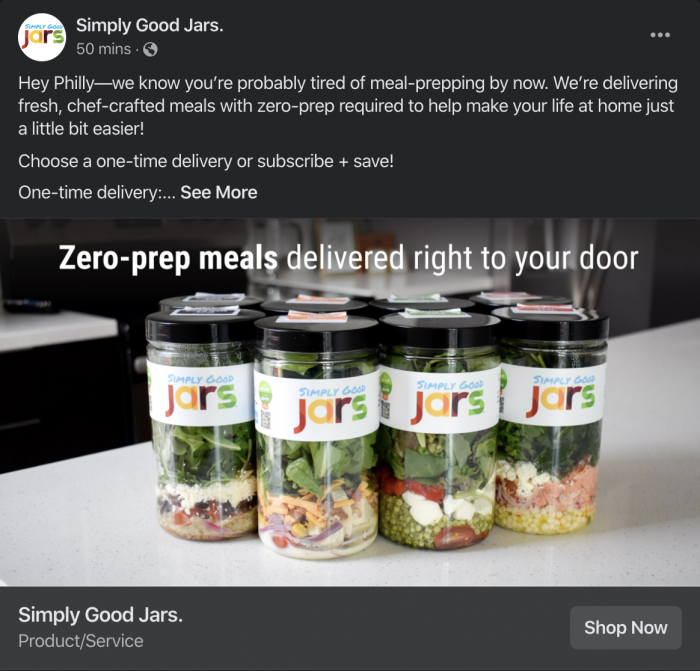
While residential delivery wasn’t initially part of their business model, it’s opened up a long-term opportunity to capitalize on the growing trends of meal-prepping and zero-waste movements. Margins are low right now but ideally, with some strategic planning and investments, the company can work to raise the margins and build out a sustainable aspect of the business.
They’re not just focused on delivery, though: in the months before the crisis, the company was focusing on building out retail-based sales, which has become even more important in the short-term due to the low margins of home delivery.
As a result, Jared Cannon, CEO of Simply Good Jars, says they’re going to focus primarily on their retail model moving forward, as it is effective both during the crisis and post-COVID given the way their product is packaged. In fact, similar to ghost kitchens, much of what they’re working on right now will be relevant in a post-COVID world. They’re taking additional measures to ensure a sanitary packaging process and final product, all of which they’re planning on implementing permanently.
The company has also been contacted by food and hospitality organizations who are rethinking the idea of salad bars and are looking for other options. Even once life goes back to a more recognizable state of normal, salad bars and buffets are going to be one of the last things to come back, if at all. This opens up a valuable opportunity for Simply Good Jars and other businesses that can supply a sanitary alternative. As Simply Good Jars works on surviving this crisis, they’re thinking long-term about the future of food in a post-COVID world, and how their product can fill a need for no-contact, social distance-approved meals.
Key Learnings
While business locations will reopen sometime in the nearish future, this situation may permanently alter the way the food and beverage industry does business. In any case, things won’t be back to “normal” for some time, as people will be hesitant to pack into restaurants and bars or load up at the salad bar. What does your business look like in a socially distant world? Are there adjustments you can make to your business model, product offerings, or target audience to reach a new group of people, like Simply Good Jars did?
For now, focus on reassuring people that it’s safe to eat your food and drink your beverages. Start by examining the way your product is made to ensure that CDC guidelines are taken into account, then work on communicating that message to your audience — whether that’s by taking a video camera into your facilities to show how you are focused on your employees’ and customers’ safety, updating the language on your website and other content platforms, showing your audience on social media the work you are doing to make sure they are safe, or ideally, all of the above.
Now is the Time to Launch and Expand Your E-commerce Push
E-commerce and direct-to-consumer (D2C) brands that sell packaged goods are faring okay, comparatively. They already have the infrastructure in place to sell products virtually and don’t have to scramble to set up shipping or delivery logistics. They tend to already have digital marketing set up as well, with proven tactics to reach their audience and levers to increase conversions.
Wise Ape Tea built their business around e-commerce from the beginning. Over time they built up a nice wholesale business, and sold a decent amount at live events. When Covid-19 hit, they lost all of their wholesale and event revenue, but they positioned themselves well to respond with an increase in their digital efforts, and as a result, online sales have been up.
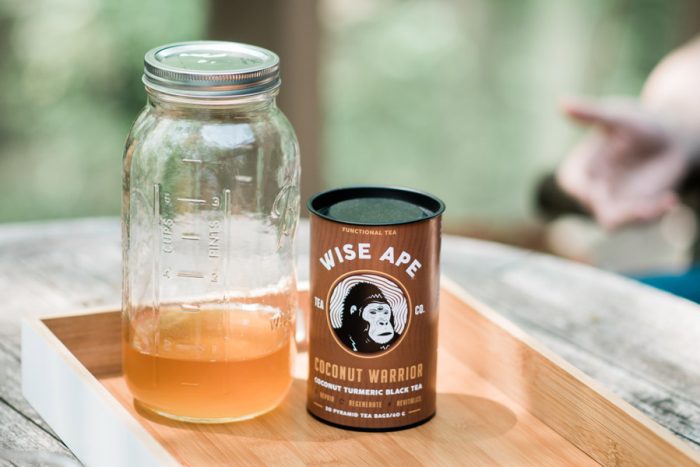
Based on increases in online activity, in the last month they’ve put extra spend behind digital marketing, including new tools for email marketing, SMS, and conversion optimization. They see this as an opportunity moving forward to test new methods of collecting and leveraging customer touchpoints. 40% of their monthly purchases are from returning customers and they are dedicated to building a strong community around the brand, as well as building robust email and SMS lists to reach their audience. In specific, they’ve started using Klaviyo for email marketing and Postscript for SMS marketing. This is leading to really high conversion rates.
Wise Ape Tea founder, Joe Scola, said that maybe the most valuable thing they’ve learned is that tea (their tea in particular) falls in the essential category for consumers. People aren’t going to skip on caffeine even in difficult times, or so it seems. They are riding the wave right now and being a lean startup with very little overhead, this may actually propel them in ways they weren’t expecting.
Another company thankful for their online store right now is Hank Sauce. They sell their hot sauce to retail stores, direct to consumers through their website, and also have a restaurant on the Jersey Shore. While grocery stores are still ordering sauces, many smaller shops that buy and sell Hank Sauce, like gift stores and surf or tackle shops, are currently shut down which has put a significant dent in sales.
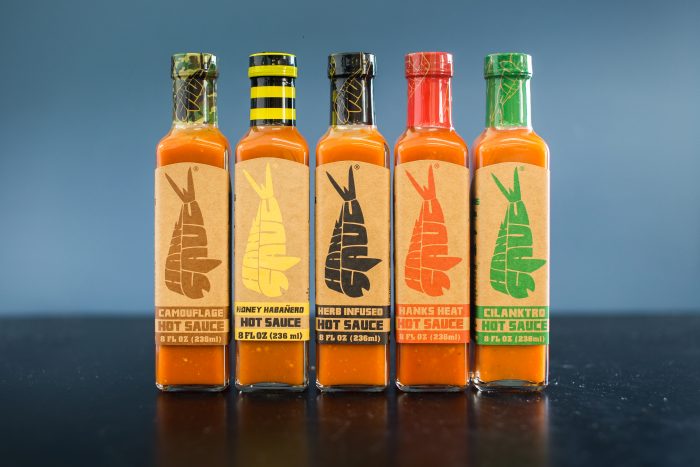
Luckily, online orders are up 10%. To help drive e-commerce sales, they’ve upped their budget for online advertising, using Google ads to drive more customers to their website. They’ve also seen a spike in followers, mentions, and engagement on their social media channels, presumably because people are cooking more than ever these days. To capture some of this increased interest, they’re pushing up the release of some specialty sauces that were originally going to be launched later in the year.
Although Hank Sauce doesn’t know what the future holds, or how their supply chain will hold up, their diversified revenue streams have been a huge benefit in the last two months of quarantine. The loss of one revenue stream (non essential mom-and-pop retail) has been somewhat offset by online and restaurant takeout sales, and grocery sales have been the backbone, giving the company a lot more stability than many others in the industry. Having an online presence and e-commerce infrastructure put them in a good position to take advantage of people cooking at home and ordering supplies online.
While it may seem daunting to set up e-commerce for your business, in reality it can be as complicated or straightforward as you’d like. It’s not too hard to get a barebones operation going. Set up a simple Shopify store, order shipping supplies, pick your package delivery service of choice, and begin selling products directly to consumers. It will be a learning process and there will definitely be some bumps in the road, but if you can navigate those bumps, it’ll be worth it in the long run as an additional revenue stream. If you’re already accustomed to selling online, then perhaps now is the time to double down on investing in improving the user experience, adding customer service and/or shopping features, or building up your paid promotions.
This can help you increase your revenue and customer base during the crisis and it also provides a foundation for the future. Let’s face it: no one knows what the future holds right now. But there are a few things we do know for sure, and one of them is that online shopping, already a huge industry, is only going to become more lucrative and popular in the age of social distancing.
Key Learnings
Outside of reaching customers via the internet (which is obviously a plus right now), one of the biggest benefits of e-commerce is the fact that you have more control over your customer base and how you reach your audience. With properly planned and executed end-to-end digital campaigns, it’s relatively easy to reach your target audience and convert them into customers.
With high internet usage across the board and increased traffic to e-commerce sites, there is an opportunity to learn more about your target audience and customer base in a shorter amount of time than ever before. Analytics can be set up to track the entire customer journey in order to identify what’s working and which levers you can pull to increase sales. Like Wise Ape Tea, you can run engagement campaigns to re-capture previous customers — with e-commerce, it’s trivial to set up these kinds of campaigns because you already know your customers’ information and buying behavior.
New Offerings Designed for Strange Times
Many food and beverage companies are turning to new products and offerings to continue reaching customers and keep the revenue coming. From turning their restaurants into grocery stores, delivering bulk meal prep kits, and offering DIY meals and family style meals for pickup, these businesses have gotten pretty creative.
Restaurants like South Philly Barbacoa are supporting their communities and their businesses by offering family meals for great prices. By paring down their menus and offering food in bulk, they’re simplifying their operations while still bringing in revenue and feeding their customers. South Philly Barbacoa is selling food by the kilo (or half kilo) with meat, tortillas, salsa, and everything you need for a wholesome Mexican meal.
Dock Street Brewery and Lost Bread Co are going the single-serving route, offering DIY pizza kits for pickup. Making homemade pizza is easier than you’d think but making your own dough can be intimidating, so these companies have stepped up to fill that gap, offering kits with dough, sauce, and cheese, and of course, instructions. Lost Bread Co is going one step further and offering a sliding scale on payment for people facing financial hardship. This is a great way to keep revenue coming, keep your brand top-of-mind, support your community, and of course, keep the people supplied with delicious pizza. Because if there ever was a time when we need that sweet comfort of some delicious pizza, it’s now.
Taiwanese restaurant Baology has teamed up with El Merkury and Jezebel’s to deliver meal prep kits to Philly and the suburbs. Argentinian restaurant and bakery Jezebel’s is selling empanadas that can be kept in the fridge and reheated at will, as well as bulk offerings of soup and sides. Central American eatery El Merkury has a huge menu available, from ready-to-eat family meals including prepared protein by the pound, to kits to cook your own pupusas, dobladas, and taquitos, and all the bulk sides and sauces anyone could ever want. Baology is offering everything from ready-to-eat meals in bulk, to frozen dumplings and build-your-own bao kits.
One trend that has taken not just Philly, but the entire country, by storm is pre-selling gift cards for restaurants to be used once dining rooms are allowed to open. This lets customers support their favorite local restaurants so that they’ll still be around once everything returns to a more-normal state. #SavePhillyEats popped up to sell not only gift cards, but experiences, packages, and discounts from local restaurants to be redeemed after the crisis. It’s something like a silent auction in terms of what’s on offer, but without an auction — you just purchase what you want.
Triple Bottom Brewery got creative and teamed up with a few local businesses to create and distribute the Joybox, the “essential non-essential” items to make your sheltering-in-place a whole lot more fun. The boxes are available for pickup or delivery (within Philly) and contain items from Weckerly’s Ice Cream, Càphê Roasters, Lil Pop Shop, Third Wheel Cheese, Mycopolitan Mushrooms, and of course, Triple Bottom. And happily for these companies, the boxes are being sold faster than they can stock them. In times like these, we all need a little joy and indulgence in our lives, and these companies have stepped up to provide it.
Key Learnings
There’s a recurring theme here: customer needs and wants have changed. These companies have made moves to capitalize on those changes and as a result, have added an additional revenue stream. While some moves are more involved than others, even a simple product offering like the DIY pizza kit can go a long way towards supporting revenue and keeping staff employed.
Think about what your customers want right now and how you can adapt to continue to serve them. What makes your business unique? How can you tweak that right now? Is there something you can do in the next 24 hours to get something out the door? If you have relationships with any other business owners in your position, reach out to them and see if you can team up to provide a joint offer that benefits your customers and your businesses.
And don’t forget: just because something may not be “essential” for your customers, that doesn’t mean they don’t need it right now. As the popularity of the Joybox shows, for a lot of people, a little comfort and joy is absolutely essential.
Go to Where the Conversation is Happening
One challenge that food and beverage companies have all experienced to some extent is how to reach their audience when everyone is stuck at home. Customers aren’t necessarily in tune with which of their favorite or nearby restaurants are still open, which delivery services they are on, if they’re doing in-house delivery, or what products are even available. And customers don’t really have the time to check each restaurant, one-by-one. So it’s crucial for brands to find their customers and relay the message about the current state of the business.
How do you do that? Well, for one, by going to customers where they are hanging out. And we all know where they’re hanging out: on the internet. People are more engaged than ever on social media, with usage up on Snapchat, Twitter, NextDoor, and Facebook, Instagram and WhatsApp. As our previous article in this series discussed, for most of these platforms ad revenue has dropped as well, resulting in extremely low ad rates for businesses looking to invest in digital advertising.
Many local restaurants have turned to Instagram as the lifeline to their customer base during this crazy time, some even accepting pickup and delivery orders through direct messaging on the platform. Mostly, brands are providing updates on their hours and instructions on how to order food, as well as menu updates, and general delicious food content to get their fans’ mouths watering.

Another trend we’ve seen is brands taking to the neighborhood social network NextDoor to provide business updates, connect with the community, and even offer ad-hoc delivery services.
The founder of Triple Bottom Brewing got on NextDoor and offered to deliver orders door-to-door in her neighborhood on her way home in the evenings. This achieves two things: one, she’s providing value to her community, who will remember the gesture for a long time. Two, she’s generating revenue for her company in a lean and agile fashion — there’s no fancy delivery service to take cuts, no digital infrastructure needed, no driver to pay. Of course, this isn’t a scalable service and isn’t sustainable long-term, but it’s a way to survive right now.
It seems obvious to be active on social networks right now, and it is — but it’s also genius, because your customer base is already on these platforms looking for meaningful information and updates, even more so than under normal circumstances. This makes discovery passive for customers, which greatly increases the chances of a customer ordering from your business. Instead of the customer having to do a ton of work researching which restaurants are open and what the status is, they have that information handed to them on a silver platter as they scroll through their feed.

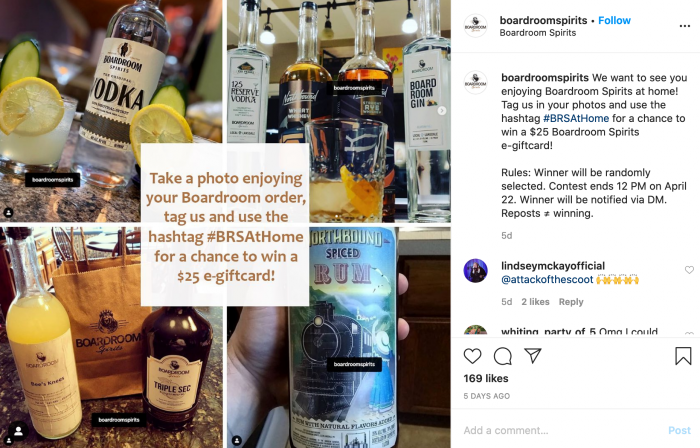
This is brand awareness at its finest. The way customers interact with food and beverage brands has completely changed as a factor of staying at home. They aren’t out and about, hitting restaurants as they get hungry and popping into bars after work for a drink. Ordering food and drink is a much more conscious decision now. It’s still based largely on convenience, but what convenience means has changed. So it’s essential to get your brand in front of the eyes of your audience, because that’s the only way your brand will even cross their mind.
Key Learnings
Social media has always been a great way to increase brand awareness and connect to your audience, but right now it’s both easier and more important than ever to do so organically – meaning at a significantly reduced cost to businesses than before. E-commerce spending in the US in March and April is up 30% compared to the same time last year. Your social channels can help you capture this lift in online spending. There is tremendous value to meeting your customers where they are, so they don’t have to step one inch out of their way to find you. Staying top-of-mind, participating in the conversation, and connecting with your audience as individuals can make that crucial difference between your audience ordering from you or from some other brand.
Support Your Community and They Will Support You Back
One of the best things you can do in this moment is foster goodwill in your community. Right now, people are highly attuned to how brands are reacting to this crisis. Brands that are helping right now will be remembered when this is all over.
La Colombe Coffee Roasters has stepped up, sending draft lattes to the front lines, supplying medical workers with their signature drink. They haven’t publicized this move much, beyond retweeting thank you posts from grateful hospital staff, but they did get a shout out in the New York Times.
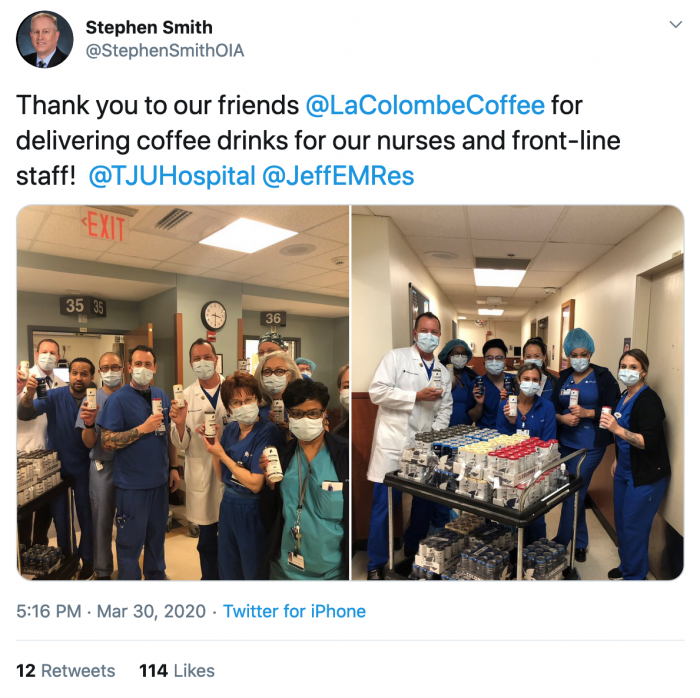
Simply Good Jars has also joined in on the good vibes. They’re supplying free jars to hospital workers. By reaching out to some Philly philanthropists who agreed to pay the cost for the jars, the company is able to benefit the community without sacrificing their own chance at surviving the crisis. They’re currently supplying $2,500 worth of food each week to Philly medical staff which is also keeping their production active even if its producing at cost.

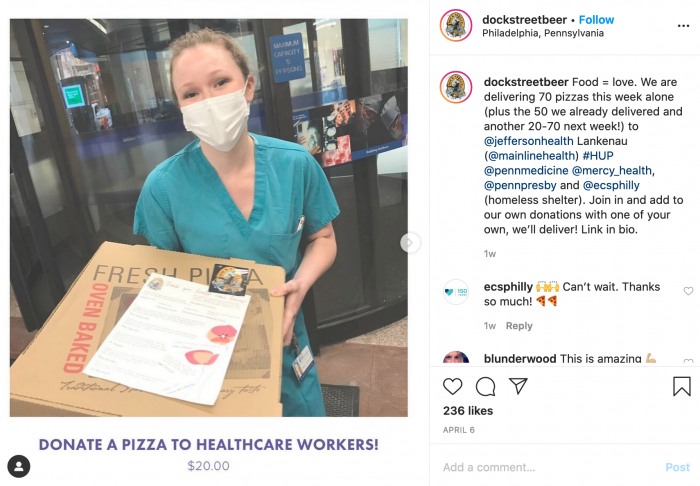
One trend that has blown up in the past few weeks is distilleries stepping in to manufacture sanitizer. Boardroom Spirits teamed up with Free Will Brewing and Sand Castle Winery to produce ethanol and start pumping out hand sanitizer. They’re providing sanitizer in bulk to essential businesses and giving it out for free to members of the community.
“The hand sanitizer production has helped us stabilize our business and keep members of our staff employed,” co-owner Zsuzsa Palota says. “Buying from others has helped maximize production and has helped create purchasing programs to put money back into our local economy.” One Brolik team member recently headed over to Boardroom to pick up some bottles and was told that out of the ten people in line ahead of him, eight were there just to pick up hand sanitizer.
Many other distilleries in the area are also manufacturing sanitizer. New Liberty, Faber, Bluebird, Five Saints, and many more — it’s amazing how quickly these brands were able to pivot to producing an entirely new product and start distributing it to essential workers and the general public.
Key Learnings
Supporting your community in a time of crisis is wonderful in itself, and that’s enough reason to pitch in and help — but there’s something more to consider here. When consumers hear about brands reaching out to the community and helping people, they are more likely to buy from those brands in the future. In particular, the younger generations take this into account when making buying decisions. So while you’re benefiting the community, your company also benefits in the long-run. There’s no better win-win than that, really.
Next Steps
Most companies didn’t have a plan for the kind of mass global upheaval we’re going through right now. That’s understandable, but now is the time to create a plan and start moving forward. Look at your market and the behaviors of your audience. Some industries are trending up, some down, some pivoting towards one offering, but all are seeing new and creative business and marketing tactics take root.
You need context to know what to do next: Is your audience motivated towards your product or service, or away? Is that true across all of your products or services? How could you change your marketing channels and product or service distribution to reach them now?
If you need help determining next steps, are looking to shift towards digital marketing, or just need some guidance in uncertain times, we’re offering marketing consultations for businesses, free-of-charge — it’s the least we can do right now to support our community! Contact us today to set up your complimentary consultation.